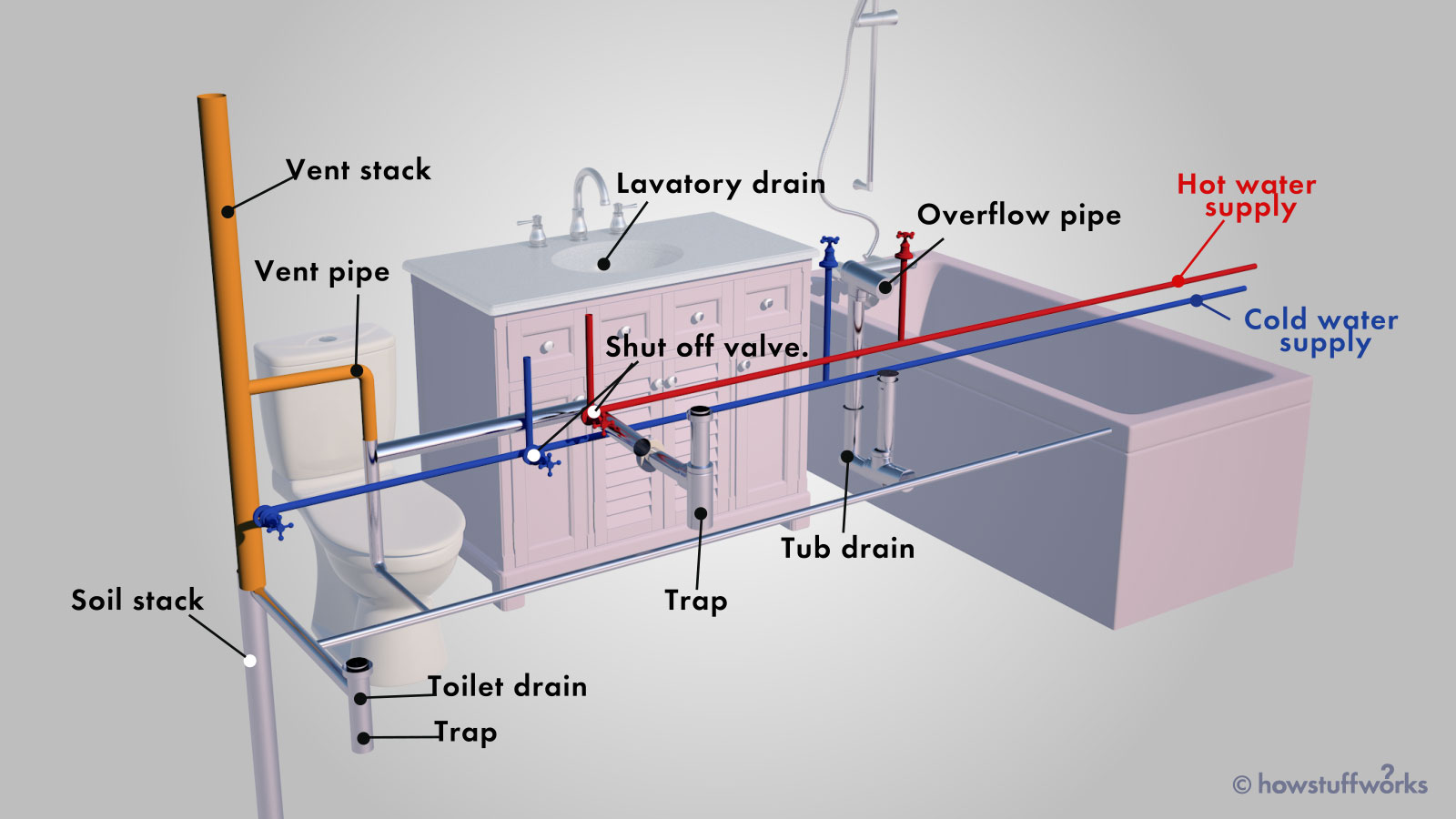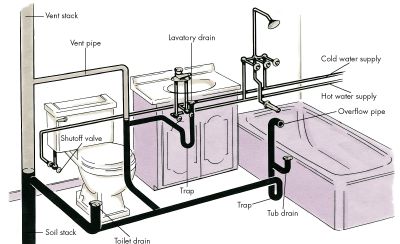How Your Home's Plumbing System Works: Design
How Your Home's Plumbing System Works: Design
Blog Article
Just how do you actually feel in relation to Understanding Your Home's Plumbing Anatomy?

Understanding just how your home's pipes system functions is essential for every property owner. From providing clean water for drinking, cooking, and bathing to safely removing wastewater, a well-kept pipes system is vital for your household's wellness and convenience. In this detailed guide, we'll discover the complex network that makes up your home's plumbing and deal suggestions on upkeep, upgrades, and dealing with usual issues.
Introduction
Your home's pipes system is greater than just a network of pipelines; it's a complicated system that ensures you have accessibility to clean water and effective wastewater elimination. Knowing its elements and just how they collaborate can help you protect against costly fixings and guarantee every little thing runs smoothly.
Fundamental Components of a Pipes System
Pipes and Tubes
At the heart of your plumbing system are the pipelines and tubing that lug water throughout your home. These can be made from various products such as copper, PVC, or PEX, each with its advantages in terms of durability and cost-effectiveness.
Fixtures: Sinks, Toilets, Showers, and so on.
Fixtures like sinks, bathrooms, showers, and bath tubs are where water is used in your house. Understanding just how these fixtures link to the pipes system assists in detecting issues and intending upgrades.
Valves and Shut-off Factors
Valves regulate the flow of water in your plumbing system. Shut-off shutoffs are essential during emergencies or when you require to make repair work, enabling you to separate parts of the system without disrupting water flow to the entire residence.
Water System System
Key Water Line
The primary water line attaches your home to the community water system or a private well. It's where water enters your home and is distributed to various fixtures.
Water Meter and Stress Regulatory Authority
The water meter measures your water usage, while a stress regulatory authority guarantees that water moves at a secure pressure throughout your home's plumbing system, protecting against damage to pipes and components.
Cold Water vs. Warm water Lines
Recognizing the difference in between cold water lines, which provide water straight from the main, and hot water lines, which bring warmed water from the water heater, aids in repairing and preparing for upgrades.
Water drainage System
Drain Pipes Water Lines and Traps
Drain pipelines bring wastewater far from sinks, showers, and bathrooms to the sewer or sewage-disposal tank. Catches stop sewer gases from entering your home and additionally trap debris that can trigger obstructions.
Ventilation Pipelines
Ventilation pipelines permit air into the water drainage system, avoiding suction that could slow down drain and cause catches to vacant. Appropriate air flow is important for keeping the integrity of your plumbing system.
Significance of Appropriate Water Drainage
Ensuring proper drain stops back-ups and water damages. Routinely cleaning up drains pipes and maintaining catches can protect against pricey repair work and expand the life of your pipes system.
Water Furnace
Types of Water Heaters
Hot water heater can be tankless or traditional tank-style. Tankless heaters warmth water on demand, while tanks keep heated water for instant use.
Upgrading Your Plumbing System
Reasons for Upgrading
Upgrading to water-efficient fixtures or replacing old pipes can improve water quality, reduce water bills, and enhance the value of your home.
Modern Plumbing Technologies and Their Benefits
Discover innovations like wise leak detectors, water-saving bathrooms, and energy-efficient water heaters that can save money and decrease environmental impact.
Cost Considerations and ROI
Compute the ahead of time prices versus lasting financial savings when taking into consideration pipes upgrades. Several upgrades spend for themselves with minimized energy expenses and less fixings.
Just How Water Heaters Attach to the Pipes System
Comprehending exactly how water heaters link to both the cold water supply and hot water distribution lines helps in diagnosing problems like inadequate hot water or leaks.
Maintenance Tips for Water Heaters
Frequently purging your hot water heater to eliminate debris, inspecting the temperature setups, and evaluating for leaks can expand its life-span and enhance energy performance.
Typical Plumbing Concerns
Leaks and Their Reasons
Leaks can occur as a result of aging pipelines, loosened installations, or high water pressure. Addressing leakages immediately avoids water damages and mold and mildew growth.
Obstructions and Obstructions
Blockages in drains and toilets are frequently caused by purging non-flushable things or an accumulation of grease and hair. Using drainpipe displays and being mindful of what goes down your drains can protect against blockages.
Indications of Plumbing Troubles to Look For
Low tide pressure, slow drains pipes, foul odors, or abnormally high water bills are indicators of prospective plumbing problems that should be addressed without delay.
Pipes Upkeep Tips
Routine Evaluations and Checks
Schedule annual pipes inspections to catch problems early. Look for indicators of leakages, rust, or mineral buildup in taps and showerheads.
DIY Upkeep Tasks
Basic jobs like cleansing faucet aerators, checking for toilet leakages using dye tablets, or shielding subjected pipes in cool climates can stop significant pipes issues.
When to Call an Expert Plumber
Know when a pipes concern needs specialist proficiency. Attempting complex repair services without correct understanding can result in even more damage and higher repair work costs.
Tips for Lowering Water Usage
Basic habits like fixing leakages immediately, taking shorter showers, and running full loads of laundry and meals can save water and lower your utility expenses.
Eco-Friendly Plumbing Options
Consider sustainable pipes products like bamboo for floor covering, which is durable and green, or recycled glass for counter tops.
Emergency Preparedness
Actions to Take Throughout a Plumbing Emergency
Know where your shut-off valves lie and exactly how to switch off the water system in case of a burst pipeline or major leakage.
Value of Having Emergency Get In Touches With Useful
Maintain get in touch with information for neighborhood plumbing technicians or emergency situation services conveniently offered for fast response during a pipes situation.
Ecological Impact and Preservation
Water-Saving Components and Home Appliances
Setting up low-flow faucets, showerheads, and bathrooms can considerably decrease water usage without sacrificing efficiency.
Do It Yourself Emergency Fixes (When Relevant).
Short-lived solutions like making use of duct tape to patch a dripping pipe or placing a bucket under a dripping faucet can reduce damages until a specialist plumbing professional gets here.
Conclusion.
Understanding the anatomy of your home's pipes system empowers you to maintain it efficiently, saving time and money on repair services. By adhering to routine upkeep regimens and staying notified regarding contemporary plumbing innovations, you can guarantee your pipes system runs efficiently for years to come.
HOW YOUR PLUMBING SYSTEM WORKS
Which Pipes Do What?
Blue lines = fresh water supply entering the building Red lines = hot water supply entering the building Grey lines = pipes carrying waste away from the building and venting pipes carrying gases away from the building (through the roof) YOUR MAIN PLUMBING SYSTEMS
There are two main plumbing systems that support your home s basic plumbing needs one that brings clean water into your home, and one that sends dirty water away from your home. Connected to the toilet, bath, shower, and other faucets in your home, these two systems keep your water flowing in the right directions.
ACCESSING FRESH WATER
Fresh and clean water is brought into your home through the main water supply line . Filtered through one pipe, this water is pressured to flow into the various fixtures in your home at any given time.
This water can be sourced from a well located on your property, a pond or river (mostly cottages), or, as in most cases, from the city s municipal water treatment centre. However, it is important to note that water that is untreated, such as the water siphoned from ponds or rivers, may not be safe to drink. Personal water supplies always need to be treated for hardness and contaminants before consumed.
MUNICIPAL WATER SUPPLIES
Improve taste and odour Remove sediment Eliminate hardness Reduce chlorine COLD WATER SUPPLY VS. HOT WATER SUPPLY
Cold water flows into your home or building through the service line, which then distributes hot or cold water to your fixtures. This line is most commonly run through a central column that runs floor to floor. Hot water runs in short and straight pipes as the longer the pipeline, the more heat that will be lost in the transfer. Having shorter pipes also allows residents to access hot water more quickly.
WASTE WATER SYSTEM
Your wastewater system is divided into two parts pipes that send wastewater away from your home and venting pipes that send sewer gas away from your home. Sewage water travels through pipes that flush the water and waste towards local sewers that are operated and managed by your city or town. Most sewer systems rely on gravity to move the wastewater to where it needs to go.
The further away from your toilet or sink, the larger wastewater pipes become. This allows for waste to be disposed of from various parts of your home or business at once without pipe blockages. The angle and flow of these pipes are also essential for keeping your waste pipes clear of build up.
https://harrisplumbing.ca/how-your-home-plumbing-system-works/

Do you appreciate reading up on Anatomy of a House: Understanding the Components? Place a remark down the page. We would be glad to find out your responses about this write up. We are looking forward that you visit us again in the near future. Make sure you pause to share this content if you liked it. Kudos for being here. Don't forget to visit our site back soon.
View Report this page